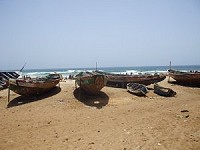 From international scientific cooperation to an arts exhibition of European and Senegalese schools. The concern about unsustainable fishing practices, degradation of marine and coastal ecosystems and social hardship to coastal communities fuelled the first steps to set up a collaboration between the 6th year secondary arts class (4h) of the European School Brussels I in Uccle of Ms. Bettina Ghallale and the College (CEM) of Kayar, a fishing village north of the Senegalese capital Dakar.
From international scientific cooperation to an arts exhibition of European and Senegalese schools. The concern about unsustainable fishing practices, degradation of marine and coastal ecosystems and social hardship to coastal communities fuelled the first steps to set up a collaboration between the 6th year secondary arts class (4h) of the European School Brussels I in Uccle of Ms. Bettina Ghallale and the College (CEM) of Kayar, a fishing village north of the Senegalese capital Dakar.
Background
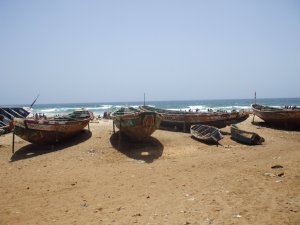 The connection between the two schools were established thanks to an international scientific cooperation project, ECOST. Scientific support was provided by the ECOST project's Dr. Aliou Sall (www.ecostproject.org) on the Senegalese side and Initiative Coordinator, Dr. Cornelia E. Nauen, formerly scientific officer at the European Commission's Research Directorate General in charge of the ECOST Project. The artistic coordination at the European School was professionally ensured by Ms. Bettina Ghallale and for the School in Kayar by Senegalese painter, Mr. Samba Laye Diop. The principal of the CEM of Kayar, Mr. Abibou Diop, supported the initiative full-heartedly, despite the limited means and outfit of the school.
The connection between the two schools were established thanks to an international scientific cooperation project, ECOST. Scientific support was provided by the ECOST project's Dr. Aliou Sall (www.ecostproject.org) on the Senegalese side and Initiative Coordinator, Dr. Cornelia E. Nauen, formerly scientific officer at the European Commission's Research Directorate General in charge of the ECOST Project. The artistic coordination at the European School was professionally ensured by Ms. Bettina Ghallale and for the School in Kayar by Senegalese painter, Mr. Samba Laye Diop. The principal of the CEM of Kayar, Mr. Abibou Diop, supported the initiative full-heartedly, despite the limited means and outfit of the school.
Kayar has been a major landing place of small-scale fishermen in Senegal, but also relied economically on its vegetable production marketing mostly in the capital. However, the fisheries has fallen on hard times, mostly as a result of overfishing. In 1997, Senegalese catches peaked at an estimated 419,000 tons, with artisanal fishermen accounting for the lion's share. Their production not only was very important for foreign currency earnings of the entire country, but also for employment and widespread benefit sharing throughout society. In 2002, at the time of a major scientific conference on half a century of change in fisheries, marine ecosystems and societies in West Africa the trend was already downwards as the scientists diagnosed. Unfortunately, the warnings of the scientists, fishermen representatives and NGOs expressed in the manifesto of the conference reprinted in the general public brochure of key results, went unheard or at least did not trigger remedial action. The current situation is therefore much more difficult to remedy than it was back in 2002.
The students in Kayar were in the age-bracket of between 14 to 16 years and usually children of fishermen, farmers and traders. They did their paintings mostly under the motto 'Man between land and the sea'. As they had not had prior art education, the expression in their paintings reflects very much their untainted perception of their surroundings in a powerful, immediate way. Because of logistic constraints, they worked with acryl colours on carton to facilitate dispatch of their works in the joint exhibition. As part of the Initiative's support to their work, the materials were paid for and the school got a portable computer and digital camera, so as to help improve local conditions.
The students of the European School Brussels I were in the age bracket between 16 and 17 years and usually children of officials of European institutions. Few if any had much prior experience with fisheries and marine culture. During art classes, they had been given a summary presentation of research results on the fisheries crisis. This was available in English and French and was also shared with Kayar. The students had then carried out additional research to identify an individual pathway to express their reaction to the problem artistically. They were given freedom in the choice of materials with the principal constraint of paying attention to cost.
The paintings from Kayar came by courier in time for the exhibition – the first direct encounter of the Brussels students with the work of their peers in Senegal. Under the supervision of Ms. Ghallale, the students in Brussels framed most available paintings from both groups. They created a mix of paintings and installations so as to create a pathway for visitors through the art works. Each piece was labelled with the name of the student. Flyers with a brief explanation were distributed to visitors in English and French.
 The student newsletter 'Connection' carried two articles about the results: one on artistic creativity and intercultural dialogue (in French) and one on the exhibition itself (in English).
The student newsletter 'Connection' carried two articles about the results: one on artistic creativity and intercultural dialogue (in French) and one on the exhibition itself (in English).
The International Cooperation Programme in Science and Technology of the European Commission reported about it.
A French press release is available here
Preparations in Kayar were supported by the local committee of artisanal fishermen, the headmaster, Mr. Abibou Diop, and teachers of the College (CEM Kayar) and guided by Mr. Samba Laye Diop, a well-known Dakar-based artist.
The following pictures capture the atmosphere of the moment.
 Dakar-based artist, Samba Laye Diop (l), and the director of the College in Kayar, Abibou Diop, prepare materials for the painting session (Photo courtesy A. Sall)
Dakar-based artist, Samba Laye Diop (l), and the director of the College in Kayar, Abibou Diop, prepare materials for the painting session (Photo courtesy A. Sall)
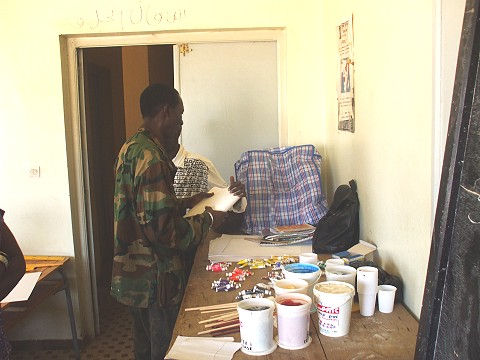 Dakar-based artist, Samba Laye Diop, prepares painting materials
Dakar-based artist, Samba Laye Diop, prepares painting materials
(Photo courtesy A. Sall)
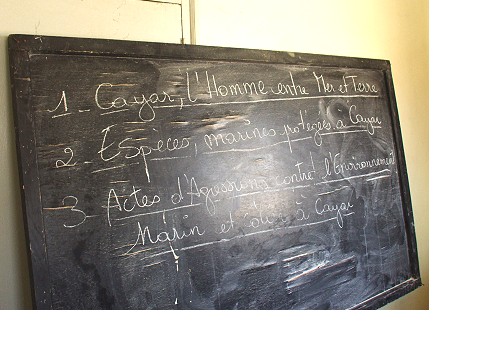 The students in Kayar could chose their painting themes from three mottos
The students in Kayar could chose their painting themes from three mottos
(Photo courtesy A. Sall)
 Members of the Fishermen's Committee encourage the students in their work
Members of the Fishermen's Committee encourage the students in their work
(Photo courtesy A. Sall)
 Kayar College students of class 6A at work
Kayar College students of class 6A at work
(Photo courtesy A. Sall)
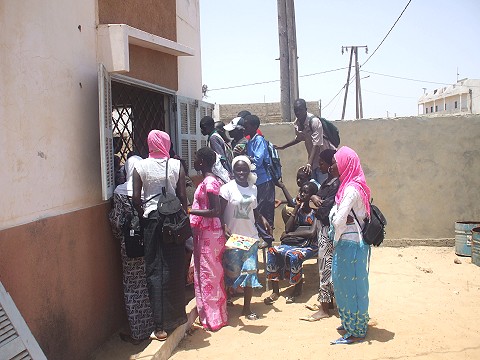 Not everybody could participate
Not everybody could participate
Curious onlookers of the painting class outside the CEM Kayar
(Photo courtesy A. Sall)
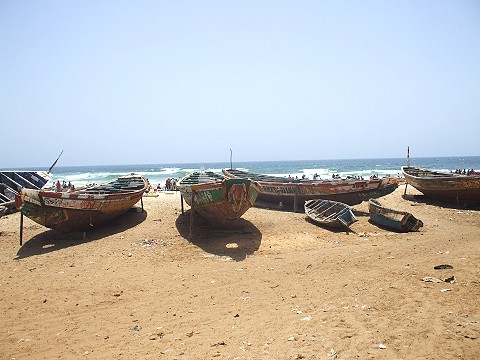 Pirogues on the beach in Kayar
Pirogues on the beach in Kayar
(Photo courtesy A. Sall)
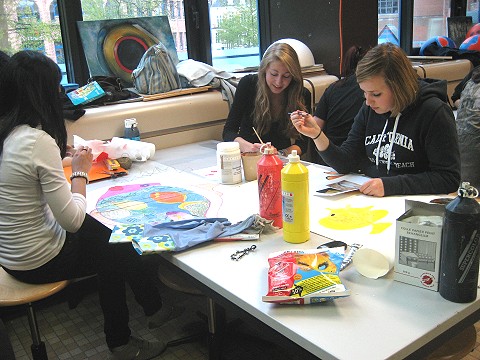 The students of the 4h arts class in 6th secondary school in Brussels (Uccle) were supported by their arts teacher, Bettina Ghallale. They used a variety of materials to create their paintings and installations. Here are some impressions of 'works in progress'.
The students of the 4h arts class in 6th secondary school in Brussels (Uccle) were supported by their arts teacher, Bettina Ghallale. They used a variety of materials to create their paintings and installations. Here are some impressions of 'works in progress'.
Works in progress - the beginning of some paintings
(Photo courtesy B. Ghallale)
 Computer-generated design in progress by Beatrice Nassi
Computer-generated design in progress by Beatrice Nassi
(Photo courtesy B. Ghallale)

Louisa Madders is outlining her painting
(Photo courtesy B. Ghallale)

Preparing installations requires more space than available in the classroom
(Photo courtesy B. Ghallale)

Work in progress on the installation by Irene Chamorro Guindel
(Photo courtesy B. Ghallale)
 Hristo Kouzmanov prepares his installation with Charlotte Meyer looking on
Hristo Kouzmanov prepares his installation with Charlotte Meyer looking on
(Photo courtesy B. Ghallale)









